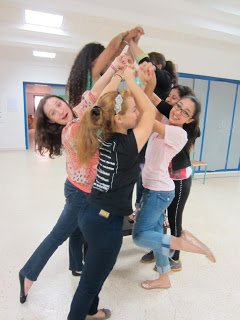Tapping in to the Multiple Intelligences
One of the best things about being a drama teacher is that there is an expectation by everyone that the learning in the classroom will be kinesthetic. In fact, the nature of “drama” allows for a fantastic venue to tap into all of the multiple intelligences either through classroom lessons or formal productions. Here is a simple lesson, which will illustrate this point, and can be used for any age group of students. I’ve selected the telling aloud of a favorite fairytale but you could tell about “The movement of blood in the body”…or any topic…
Storytelling- “Jack in the Bean-Stalk”
With Grade 9 students at Casablanca American School, Casablanca, Morocco.
Making it Intrapersonal
Break students into groups of 5 to 7 and ask them to work as a “team” to act out several scenes they will hear as I tell them a story. (In cultures where there is gender restrictions or when working with older teenagers, sometimes it works well to dived students into all boy groups and all girl groups. Otherwise, to preserve gender equality, random separating is fine).
Making it Kinesthetic
Explain that they will “construct with their bodies” something that will express a certain part of the story.
Making it Spatial
Designate an area and optional props that can be used. I have several large Moroccan rugs in my classroom which easily become a “play and design space”.
Storytelling- “Jack in the Bean-Stalk”
With Grade 9 students at Casablanca American School, Casablanca, Morocco.
Making it Intrapersonal
I introduce the story with a personal connection…when I was a little girl, my mother told me this story. I am thinking that you may know it too…
(This lesson makes a great introduction to a “storytelling” unit or project in which each student tells one of their favorite stories with plenty of facial animation, vocal expression and body gestures).
Making it Musical
Play a classical piece of music in the background as you tell your story. For my story of “Jack in the Beanstalk” I selected, “Scenes of Childhood” Op.15 Kinderszenen. Pause the music as students create their human sculptures.
Making it Visual
As a “backdrop” to the storytelling, you can project a favorite painting for inspiration or ask students to close their eyes as I begin the story and use their imagination to see a scene in their mind. You may want to invent and describe a place that is beyond the traditional version or Disney one…
Storytelling- “Jack in the Bean-Stalk”
With Grade 9 students at Casablanca American School, Casablanca, Morocco.
Making it Linguistic
At any point, you can stop the movement and ask students to write or draw a section in their own way. Sometimes, I have stopped the action just before the ending and asked students to devise their own ending on paper first in written form before acting it out. As an extension exercise, ask pairs of students to be the narrators of a “twisted” or different fairytale by taking turns improvising the story and selecting different students to be the actors.
Making it Logical
Draw a design for a set “to scale” for one of the scenes or discuss the actual height of a real beanstalk and compare that with the distance to the clouds…
Storytelling- “Jack in the Bean-Stalk”
With Grade 9 students at Casablanca American School, Casablanca, Morocco.
Note-teaching in this holistic manner brings its own challenges as a teacher, such as the management of physical behaviors and the teaching of self-discipline and reflection so that “play” becomes a serious tool to learning.




